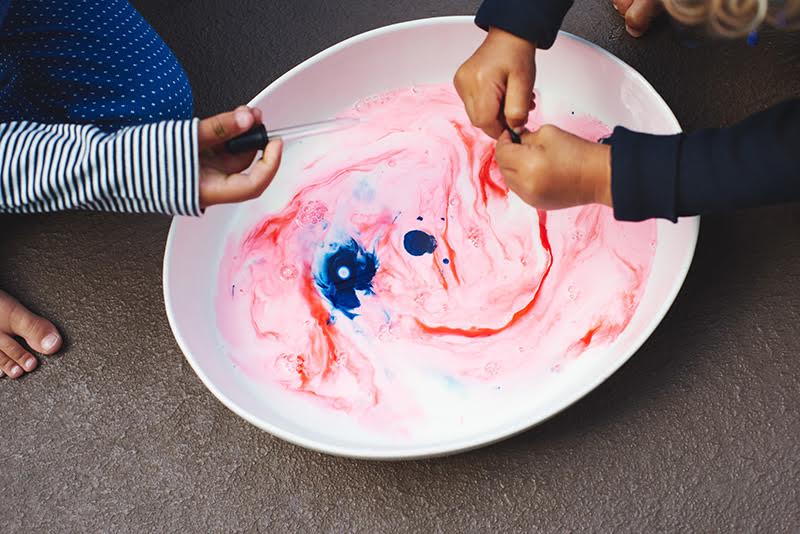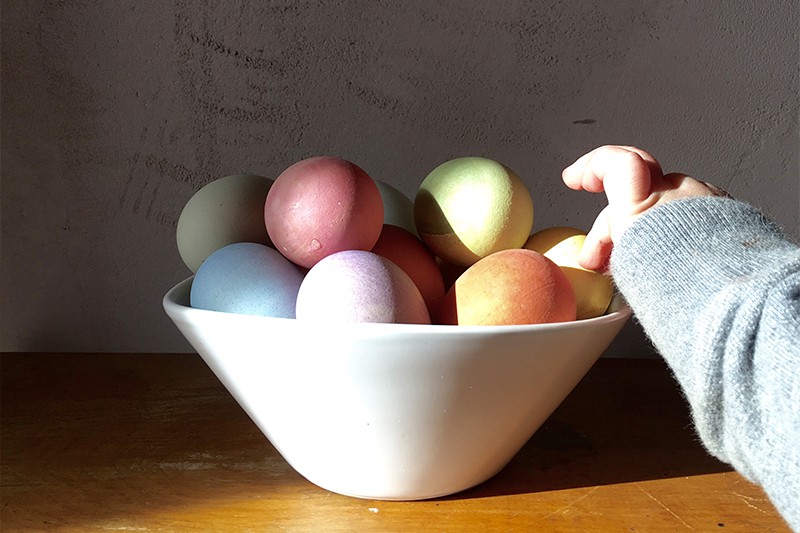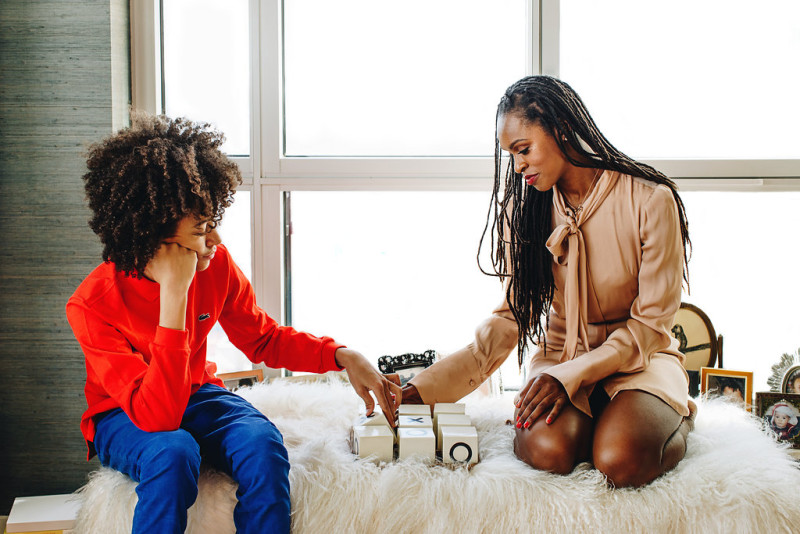
5 Montessori-Inspired Activities for Elementary-Aged Kids
Written by Sara Langer
Photography by Photographed by Maria Del Rio; Clothing by Tea Collection
Not too long ago we shared some fun, independence-building Montessori activities you could do at home with your toddler or preschooler. Thanks to popular demand, we’re now sharing a another handful of exercises to try with your older kiddos. Whether or not your children attend a Montessori school, bringing simple, inspired activities like these into your home is a great way to incorporate some of the core Montessori values—such as independence, exploration, and appreciation of the arts—into your school vacations or rainy weekends at home. Below, five “lessons” perfect for elementary-aged kids.
Color Theory: Marbled Print Making
Supplies:
Milk (works best with any kind of milk other than non-fat)
Food coloring
Liquid dish soap
Shallow dish or plastic tray
Cardstock
Droppers (optional)
Directions:
Pour enough milk into the tray or dish, so that there is a shallow layer covering the bottom. Add a few drops of food coloring to the tray. Add a few drops of dish soap. Wait and watch for 30 seconds as the soap breaks down the fat and protein in the milk and swirls of color begin to form. You can use a finger or a spoon to create more swirls for a marbling effect. Dip the cardstock (regular paper works, too, but the thicker the better) into the tray or dish and let it sit for just a few seconds. Lift and transfer to dry on a flat surface. Repeat mixing different colors together.
Science Experiment: Exploring Gas
Supplies:
Baking soda
Vinegar
Plastic bottle
2 funnels
Balloons
Directions:
Place one funnel in the plastic bottle in order to pour in the vinegar, filling the bottle about a third of the way. Using the second funnel, pour the baking soda into the balloon, filling it about half full. Carefully cover the top of the plastic bottle with the opening of the balloon (the same way you would put water balloons around the faucet or hose to fill them) making sure not to let any of the baking soda fall into the bottle yet. Once the balloon is securely on the bottle, lift it up and allow the baking soda to fall into the vinegar. The mixture will begin to bubble and fizz and the balloon will expand. Your kids will probably want to repeat this one a few times! Explain to them how the a gas is created by mixing the baking soda and vinegar. Baking soda and vinegar create what is called an “acid-base reaction.” When combined, they create carbon dioxide (gas). The gas needs room to spread, hence filling the balloon.
Creative Mathematics: Geometry Stars
Supplies:
Paper
Pencil
Ruler
Colored Pencil
Directions:
This activity can incorporate a lot of mathematical terms (point, line, line segment, end points, acute, right, and obtuse angle). It is up to you how much of this terminology you want to include in your lesson/activity. Using the ruler, draw a two inch line in the middle of the paper. This is a line segment and can be labeled with endpoints, A and B. Draw 15-20 dots (points) all around the paper. Using the ruler, draw a line segment from each point to both A and B. If you want to add some mathematical discussion here, you can talk about what kind of angles the lines created. Once all the lines are drawn, color or pattern each part of the star as desired. It can be cut out and mounted on color paper if you want. The end product should look something like this.
Visual Book Report: Recreating the Story with Found Objects in a Diorama
Supplies:
Shoe box
Other supplies will vary depending on the needs of the child.
Directions:
Have your child choose one of their favorite books and discuss how they can create a 3-D image of the story in a diorama. They can choose a specific part of the book or story, or a scene that would represent the story and the characters as a whole. Here’s where the independence is kicked up a notch: Have them search around the house (and maybe outside, too) for the supplies they would need to create this diorama. Make sure they check in with you about whether or not it’s ok to use what they found. Then, let the creating begin! Discuss the meaning of what they created and how it relates to the book.
Continent Study: Crafts from Around the World
Choose a craft from each continent and discuss its orgins. Here are some ideas of crafts from around the world.
North America: Make a dream catcher using found twigs, feathers, and twine to tie it all together.
South America: Inca clay figurines or tools. Use potter’s clay to recreate ancient Incan statues or tools.
Europe: Choose an artist, like Monet and recreate one of his pieces or create an original in his impressionist style of painting. Q-tips and tempra paint work great for this activity.
Asia: Create a dragon for Chinese New Year. Toilet paper or paper towel rolls can be used to create the body of the dragon. Construction paper or cardboard can be cut to create the head, limbs, and wings. Use tissue paper to make the dragon look like it’s breathing fire. Check out this great example.
Africa: Try your hand at Mudcloth or Andire fabric with resist dying. You can get Indigo Dye Kits for a reasonable price online. They come with instructions on how to create different patterns. You can use old sheets, cut up into smaller pieces or those stained white t-shirts you were about to discard.
Australia: Make a didgeridoo out of a cardboard paper-towel roll. Put a balloon over one end and cut off the top to make the mouth piece. Decorate the cardboard with Aboriginal symbols.
Antarctica: Recreate black and white photographs of the glaciers taken by early explorers using black and white construction paper and a quick search on google images.
Share this story




